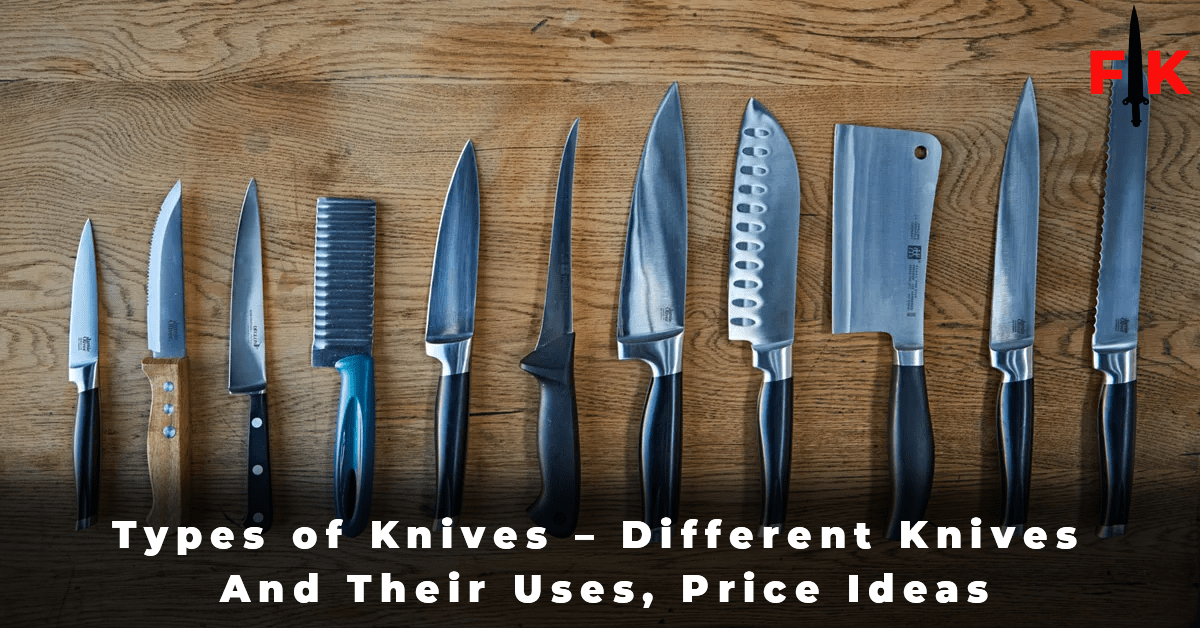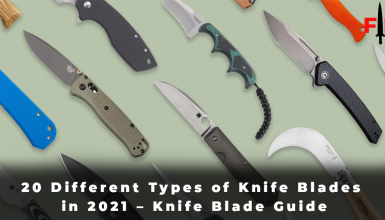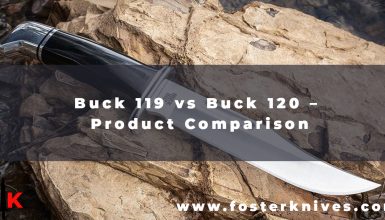Preparing food is an art and having the best tools can make this art perfect. One of the main important tools in the kitchen is a knife. Knives are as important as spices. Like the spices add flavors to the food, the right type of knife will provide precise cuts to the food without ruining its texture.
There are many types of knives like chef’s knife, santoku knife, paring knife, and so many. And each type is specially designed for a specific purpose as a chef’s knife is a multi-purpose and all-rounder knife and is used to perform many of the kitchen tasks like chopping, slicing, mincing, etc.
Choosing the right kind of knife enables us to prepare food easier and faster. It’s a trick to get out the right type of knife which suits our requirements. Right knowledge helps us to find out the product we need. The In-depth analysis provides information about the performance and quality of knives.
So, if a person is aware of different types of knives and their application, it will assist that which knife will be effective for one type of food that may not work well on others. In this topic, we’ll discover each kind of knife and also describe their properties like which knife is appropriate for the specific kind of foodstuff.
Table of Contents
What is a knife sharpener called?
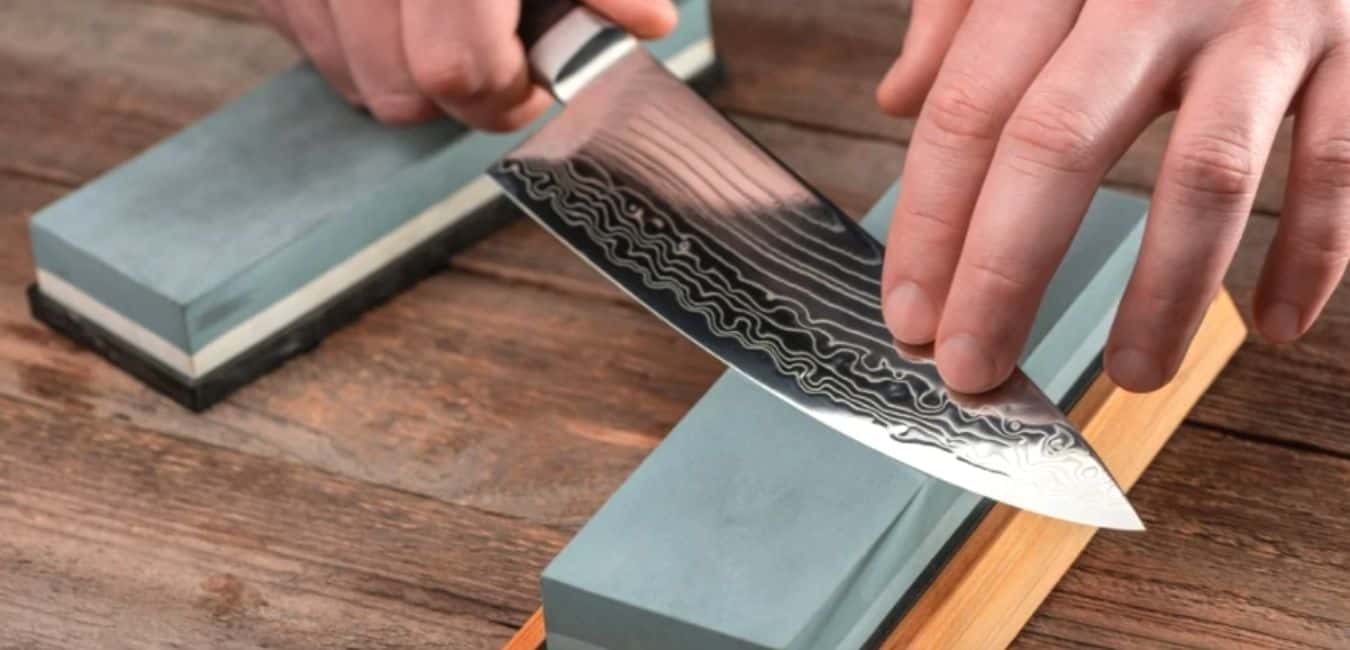
It is a tool that is designed to file the cutting edges on the steel blades of a knife. A knife sharpener can be as simple as a round sharpening stone or as complex as multi-functional machines having multiple sharpening stones. The simplest sharpening stone is most often made as a rectangular or round shaped stone with a thickness of half to several inches. Most commonly used examples include the whetstone or the carborundum stone.
Another variety of knife sharpeners is the sharpening steel that consists of a round or elliptical steel shaft with a finely textured grinding surface to sharpen knife edges manually. The knife blade is drawn across the steel and is held firmly in space.
Types of knives and their uses
The types of knives available in the market are as follow;
- Forged knife
- Stamped knife
- Chef knife
- Utility knife
- Paring knife
- Bread knife
- Carving knife
- Cleavers or butcher knife
- Boning knife
- Steak knife
- Slicing knife
- Prep knife
- Filleting knife
- Salmon knife
- Santoku knife
- Nakiri knife
- Tomato knife
- Peeling knife
1. Forged knives
 Forged knives are made up of a single bar of steel. They are first heated and then hammered into desired shapes. Then a handle is added before the blade undergoes final polishing. During the forging process, hammering rearranges the molecules of steel making them harder and stronger. And thus, provides prolonged durability to the edge.
Forged knives are made up of a single bar of steel. They are first heated and then hammered into desired shapes. Then a handle is added before the blade undergoes final polishing. During the forging process, hammering rearranges the molecules of steel making them harder and stronger. And thus, provides prolonged durability to the edge.
Forged knives are heavier giving more weight and power behind each cut. The blades of forged knives are less flexible. They do not bend when cutting through hard surfaces and present high precision to the cut. Forged knives have bolsters which builds an extra layer of protection for fingers as it works as a natural stop for the movements.
Forged knives with bolsters are highly stable. But they have some cons too. The full tang and bolsters impart additional weight to handle that lead to fatigue for a longer time of usage.
Uses of a forged knife
Forged blades may offer better toughness and stability for precision cutting and the chopping of harder and thicker materials. They are perfect for mincing jobs.
2. Stamped knife
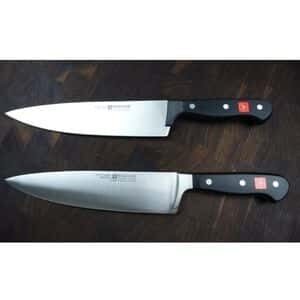
Stamped knives are prepared by cutting a large sheet of steel. Then they are cut out into the shape of a blade by using powerful stamping machines. After cutting it is honed and heat-treated ensuring higher durability. Hardening, polishing, and sharpening give a keen edge and smooth finish.
This type of knife is much lighter and more flexible than the forged knife since it is made from a single sheet of steel. They have no bolsters so they are easy to sharpen. The durability of stamped knives depends upon the material used. They ensure better grip as lack of bolsters makes them more comfortable to use.
Lightweight also reduces the risk of fatigue for long-hour usage. When cutting through hard surfaces the thinner and flexible blades may bend and slip which can reduce precision.
Uses of stamped knife
These knives are advisable for a professional chef who spends a huge tie in the kitchen since these knives are lighter and their frame leads to less fatigue over time. Since they are thinner, which makes cutting through easier and suitable for slicing.
3. Chef’s Knife
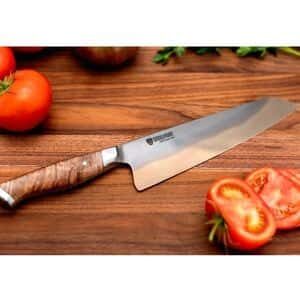
A chef’s knife is available in almost every commercial kitchen. It is a great all-rounder and multi-purpose tool that can be used for various cutting tasks. A chef’s knife has a long and broad blade with a straight edge that tapers to a pointed tip. This point is suitable for a number of prep tasks. This type of knife is made from a combination of stainless steel and carbon steel. its size ranges from 8’’-12’’. This knife may also refer as a French knife.
What is a chef’s knife used for?
It has a curved blade that permits it a rocking motion forward and backward on the chopping board and thus makes it the perfect tool for chopping, dicing, slicing, mincing, and as well as separating meat from the bone. The broad heel area makes it withstand more pressure during heavy-duty chopping work that is appropriate for cutting thicker and harder foods like potatoes, beetroots, etc.
Price ranges from $20 to $100.
4. Utility knife
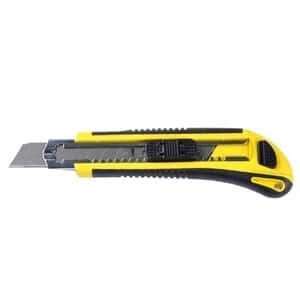
This kind is another general-use knife. It is a small lightweight tool that has a blade that is 4 to 7 inches long. It is identical in shape to a chef knife but it is smaller and thinner. They have a sharp tip that allows doing more intricate work. Utility knives are available with a straight-edge blade or a serrated blade. The serrated blade contains notches that assist in cleanly slicing soft-textured foods. It gives a little better handling than a chef’s knife-like coring, trimming, and deboning. They are an ideal tool for food prep.
What is a utility knife used for?
The utility knife can cut food items that are large for paring knives and small for a chef’s knife. Since it allows for more precise cutting work. So, it is good for chopping smaller foods and vegetables like cucumbers, smaller squash, and other mid-sized food items. it also works well for herbs and shallots and larger pieces of garlic.
Price ranges from $10 to $20.
5. Paring knife

It is the smallest and lightest type of knife. It is shorter in size with the evenly sized blade having a pointed tip. Their blade size typically ranges between 2 ¼” and 4 ½”. There are a number of different styles of paring knives that include, spear point, bird’s beak, and sheep’s foot paring knife. Due to its lighter weight, it allows easy handling during delicate work.
What is a paring knife used for?
Paring knives are great for peeling, trimming, removing seeds from fruits & vegetables. They are ideal for detailed work like creating a garnish. When we need to work on small or tender fruits and vegetables like ginger, strawberries, garlic, etc, paring knives are suitable. But it is not suited for harder vegetables like carrots, beets, squash.
They generally cost from $10 to $60.
6. Bread knife
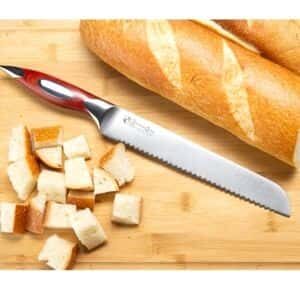
It is a type of knife that is usually long and has a sharp edge having saw-like notches or teeth, which is known as a serrated edge. Its blade length ranges from 8 to 10 inches. It is perfect for cutting something without applying pressure. The serrated edge works well on food items that have a hard crust but they are soft from the inside. But serrated edge knives are difficult to sharpen so many times.
What is a bread knife used for?
As the name suggests, it is a perfect tool for cutting all kinds of bread that includes bread, baguettes, bagels, and bread rolls. The saw-like notches permit the chef to cut through softer texture neatly without any tear or distortion of any shape. Bread knives can be used to even out sponge cakes in place of cake leveler.
The Price of a bread knife ranges from $25 to $50.
7. Meat knives: –
Since meat requires special handling and careful preparations, so, special tools are needed for meat cutting. There are different types of meat knives designed for specific purposes which give us knowledge about the right knife for which task suits them best. Now we’ll discuss different types of meat knives with their uses:
8. Carving knife
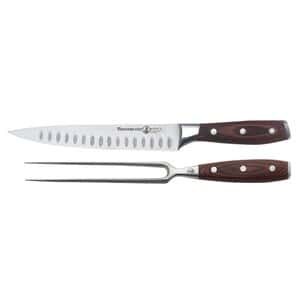
A carving knife is one of the longest knives. It has a slender blade with a sharp pointed tip. Its design ensures reduced friction and enables to move back and forth, providing thin and uniform cuts. This knife is best for slicing meat and carving legs of lambs and poultry. Meat should be stable to avoid injury while using a carving knife.
What is a carving knife used for?
Its main task is to carve lamb, poultry, pork, or beef. Due to its precision and even cutting it also works well on large fruits and vegetables like melons or courgettes which can be difficult to handle using smaller or broader knives. The carving knives are ideal for smooth cutting motion and even slicing.
Its price ranges from $60-$200.
9. Cleaver or butcher knife
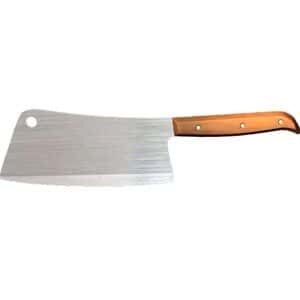
Cleaver is also known as a butcher’s knife. It is the largest knife in the chef’s toolkit. It consists of a flat and rectangular-shaped blade. Their blade is strong, tough, super sharp, and made of heavy-duty steel. It is available in different sizes which depends on the purpose of need. It is the broadest and heaviest of all knives, so it keeps a hole on its spine end so can be hung when not in use.
What is a cleaver used for?
This is mainly used in professional settings by butchers or hunters where animals are slaughtered and whole animals are being prepared. A cleaver is used in such settings for the tasks like hacking through bone and chopping up raw meat. It can be used by chefs as well in the kitchen when there is a need to chop up raw meat before cooking.
The price of cleavers ranges from $50 to $200.
10. Boning knife
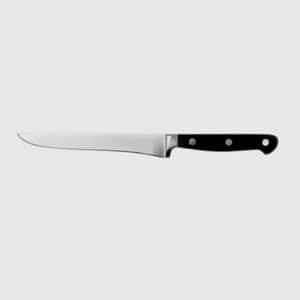
A boning knife consists of a unique design and is easy to differentiate among all kitchen knives. It has a thin blade with a sharp edge that tapers upward to a fine pointed tip.it has a little notch at the junction of the handle and blade which is also known as a bolster. This bolster acts as a finger guard and provides safety to your fingers while handling slippery ingredients. Its size is about 6 inches and occasionally rigidly constructed. But the flexible blades are available for delicate meat.
What is boning used for?
This type of knife is used for removing cartilage and short bones from the meat of lamb, pork, and poultry. They are best suited when you need to separate meat from bones without damaging flesh texture. If you need to separate fats or skin from chicken or beef, boning knives are perfect. They are lighter and flexible so u can rely on them as they are comfortable to use.
The Price of boning knives ranges from $30 to $100.
11. Steak knife
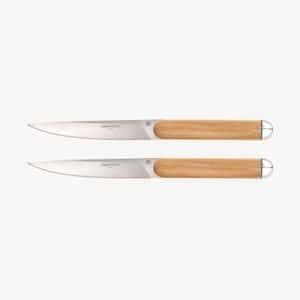
A steak knife is a sharp table knife. They are long and consist of either a straight edge or serrated edge. They are sturdy, well-balanced, handy, and comfortable to use on a table. Since they should be present on the table, they must look pretty as well and for this purpose, they come in various styles.
What is a steak knife used for?
As its name suggests, a steaks knife is used to slice steaks while having them in your meal. They are well needed to enjoy the juicy steak meal. They are also provided with meals that contain cooked meat because they allow easy cutting through cooked meat.
The price of a steaks knife ranges from $6 to $70.
12. Slicing knife

A slicing knife consists of a long and narrow blade. But its blade has an even width all along its depth, with a round & bullnose tip rather than tapering to a point. It has a unique handle and a bolster geometry. It is long enough and offers the ability for tons of horizontal motion which reduces the need for downward pressure as you slice.
What is a slicing knife used for?
Its straight edge allows making even slices in the largest roasts like a prime rib or a boneless leg of a lamb. Its edge is designed in such a fashion that prevents from adhering meat to the knife. They are also used to slice big fruits and vegetables like melons, cabbage, etc.
The price of a slicing knife ranges from $20 to $70.
13. Prep knife

A prep knife is a mid-sized knife that is a versatile, all-around tool and is ideal for the cuts that need accuracy and perfection but is too large for a paring knife. It is unique and keeps an angled bolster to tip for increased cutting precision. It has a full tang and a handle that provides comfort while using.
What is a prep knife used for?
They are generally used for prepping foods from separating meat to bones and slicing them around the joints.
Price ranges from $10 to $50.
Types Fish knives and Their Uses
Fish is slippery in texture and should be handled with great care. So, different knives are used to cut through fish which include;
- Filleting knife
- Salmon knife
- Santoku knife
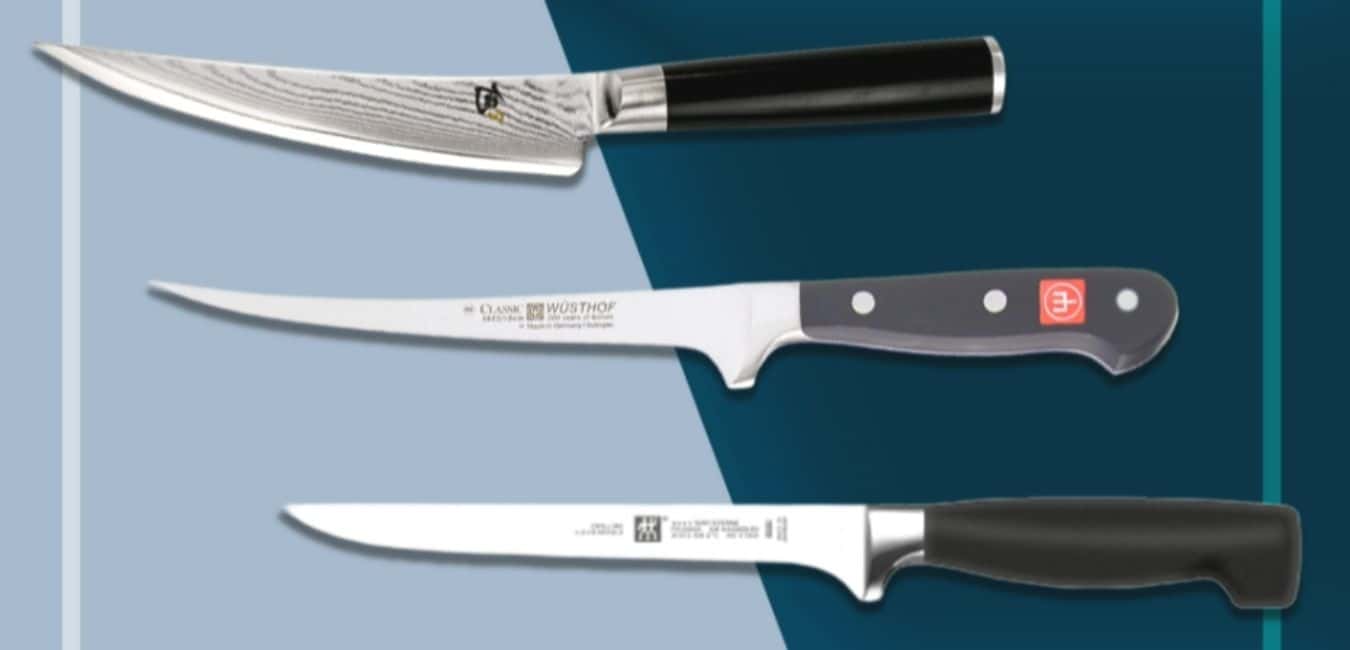
1. Filleting knife

Filleting knives are usually long and thinner with a flexible blade. It consists of a sharp edge and pointed tip that can make holes through skin and allow to separate intricate bones through flesh. It looks like a boning knife but the edge is thinner and more flexible. Their unique feature is that they cut the meat horizontally rather than vertically.
What is a filleting knife used for?
Since the specialty of filleting knives is being flexible it is used for loosening skin and bones. It is ideal and more suitable for more delicate meats like fish. It is mainly used to remove fillets with little waste. However, the knife can also be used in meat processing to easily remove tendons and skin. It is also used to process fish immediately after it is caught.
The price of filleting knives ranges from $20 to $100.
2. Salmon knife

This is a type of knife that has a long and flexible blade having a double edge. It is basically designed to fillet larger fish. It is thin and sharp that is advisable for precise fileting and removal of skin. Some designs also contain concavity along the side of the blade.
What is the use of a salmon knife?
A salmon knife is used to create thin slices, filleting and removing the skin from larger fish like salmon. They are enough lean that they can easily pass between skin and flesh without causing any detrimental effect to the delicate fish, letting the chef make neat and tidy fillets. The dimpling and concavities along the edge of the blade of a salmon knife, lessen drag during cutting and help to stop the raw fish from adhering to the metal surface.
The price of a salmon knife ranges from $20 to $200.
3. Santoku knife

Santoku is a Japanese word that means ‘’three uses”. It has a similar shape and construction as the chef knife but is shorter and thinner. It is 5’’ to 8’’ long. Its flat blade makes it more suitable for up and down chopping motion rather than the rocking slicing motion of a traditional chef’s knife. It is a multi-purpose knife and excellent for precise and fine mincing, slicing, and dicing.
What is a santoku knife used for?
The santoku knives are an efficient tool for cutting fish. They produce fine and precise cuts on other meat products as well. They are particularly beneficial when you want to prepare sushi and other dishes from the raw fish. Their use is not only confined to fish or meat, but they are also useful for the chopping and dicing of fruits and vegetables. They can be an alternate for a chef or utility knife.
The price of santoku knives ranges from $20 to $150.
Type of Vegetable knives and Their Uses
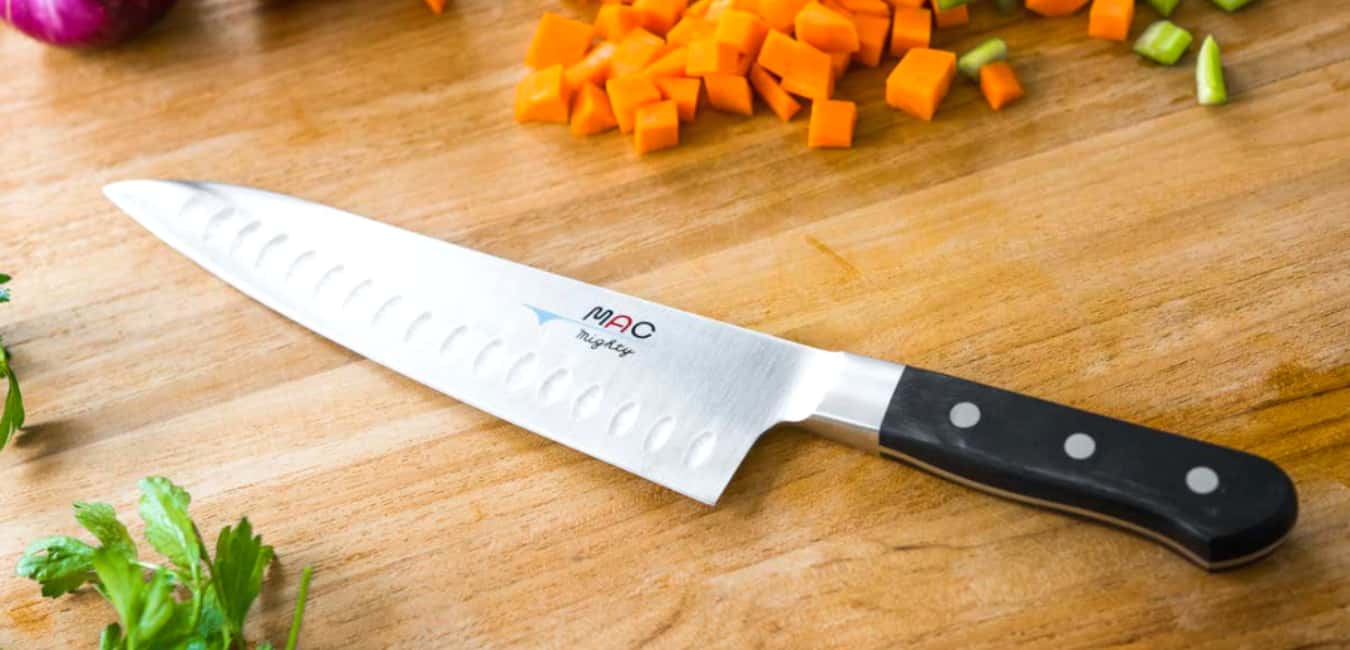
Vegetable knives include the following types: –
Nakiri knives
The nakiri knives look like cleavers but they are particularly designed for cutting vegetables. Their blade is broad and rectangular with a hollow ground edge which is very sharp and has a blunt, cut-off tip. The ideal size for a nakiri knife is 6 to 7 inches.
What is a nakiri knife used for?
Nakiri knife is the best investment for a home cook since it is an excellent tool for chopping and dicing vegetables. There is no need to rock the blade backward and forward while chopping the vegetables by using nakiri knives due to their squared shape and straight edge. This makes the nakiri knife an efficient and effective tool for the larger vegetables which are often difficult to cut, like sweet potatoes or butternut squash. Its deep and flat blade makes it a good choice for shredding vegetables like cabbage or lettuce. The intense sharp edge can create such a thin slice that you may also cut vegetable ribbons and use them in garnishing.
Price ranges from $30 to $230.
Tomato knives: –

Tomato knives are small serrated-edged knives. Their blade is about 6 to 7 inches long and they are designed to be lightweight and handy. Most of the tomato knives have a forked tip.
What is a tomato knife used for?
Tomatoes have delicate skin and a very soft texture so they should be handled very carefully using tomato knives. Their design is best fitted for peeling and slicing tomatoes. The serrated edge enables the user to perforate the tomato’s skin and slice them without tearing the flesh. The forked tip allows the user to lift and move tomato slices after they have been cut.
The price of a tomato knife ranges from $10 to $125.
Peeling knives:

A peeling knife is smaller in size with a stiff and curved blade. It keeps a sharp and non-serrated edge.
What is the peeling knife used for?
A peeling knife is mainly used for peeling off vegetables and fruits. They are even better for slicing the fruits and veggies over their skin. They keep a stout and rigid blade that allows fine cutting which prevents the knife from slippage during peeling.
The price for the peeling knife ranges from $5 to $40.
The following table below describes the distinguishing feature and the use of each knife: –
| Types of knives | Features and uses |
|---|---|
| Chef’s knife | All-rounder and multi-purpose knife, mainly used for chopping, mincing, dicing, and slicing. |
| Utility knife | Smaller and lighter weight. Suitable for smaller food objects. |
| Paring knife | Smallest and lightest in weight. Mainly used for peeling, trimming, and removing seeds from fruits and vegetables. |
| Bread knife | Usually Longer with a sharp edge. Perfect for even cutting of all kinds of bread. |
| Carving knife | Longest knife with a slender blade. Used for carving meat or poultry, and pork, etc. |
| Cleavers or butcher knife | Largest knife with the broad and rectangular blade. Ideal tool for cutting the whole animal and separating meat from the bones. |
| Boning knife | Thin knife with a sharp edge. Keeps a bolster at the heel. Can be used to cut through cartilage and bones |
| Steak knife | Sharp table knife. Used to slice and cut through cooked meat like steaks |
| Slicing knife | Consists of a long and narrow blade. Used for the perfect slicing of meat, leafy vegetables, and fruits |
| Prep knife | Mid-sized and versatile kitchen knife mainly used for food preparations. |
| Filleting knife | Long and keeps a thinner and flexible blade. Ideal for producing fillets of delicate meat like fish. |
| Salmon knife | Long and flexible having a double edge. Used to remove the skin from larger fish like salmon and slice its meat. |
| Santoku knife | Japanese knife. Similar to chef’s knife in appearance. Ideal for chopping, mincing, and dicing. |
| Nakiri knife | Looks like cleavers but is mainly used for chopping vegetables producing fine cuts. |
| Tomato knife | Thin and small serrated edged knife. Keeps a fork-like tip specially designed for peeling the delicate skin of tomatoes and its slicing. |
| Peeling knife |
What is one of the smallest knives used in the kitchen?
The smallest knife in the kitchen is a paring knife. Its length is usually 2.5 to 4 inches. It is versatile and can be used for many purposes. it is lighter in weight and can be handled easily for delicate work. It is mainly used for peeling, chopping, slicing, and garnishing. Since lighter in weight, It allows easy handling while performing a delicate work
What is a tourné knife used for?
A tourne knife is a kind of paring knife. It is short in length having a twisted blade. It is also known as a bird’s beak. It has a pointed tip with a sharp edge and is used for creating fancy and delicate cuts on fruits and vegetables and their garnishing.
Knife Edge Types
For a knife to work better, it must contain a sturdy blade. And for a blade, the most important thing is its edge which makes a blade sharp. Different types of food need different types of edges for their precise cutting. Here we shall discuss different types of edges and will find out which edge is best fitted for which purpose;
- V edge
- Convex edge
- Compound edge
- Chisel edge
- Hollow edge
- Scalloped edge
- Serrated edge
V edge
It is the most common type of knife’s edge. This shape is easy to sharpen and provides durability to the knife. It is able to perform a number of tasks.
Convex edge
It looks like the v edge but its surface is curved. When observed its cross-section, its shape is identical to a bullet. This type of edge is present mostly in cleavers. It is strong and sharp enough, but multiple sharpening tends to alter its edge into v edge.
Compound edge
It is also known as “double bevel grind”. This edge is comparatively uncommon because it is hard to sharpen.
Chisel edge
It is a favorable edge for a chef’s knife. Its one side is angled and the other side is flat. This is best suited for carving and garnishing.
Hollow edge
It also looks like a v edge but is hollow from its sides. Naikiri knives are made of hollow edges. This kind of edge needs attention while sharpening.
Scalloped edge
Sometimes, it is also known as “Granton edge”. It is composed of concavities or indentations along the side of its blade, which prevents the adhering of food particles along with the knife. So, this kind of edge is best suited when cutting a sticky food item like fish. The long salmon and santoku knives are composed of this kind of edge.
Serrated edge
The serrated edge consists of grooves and ridges which are suitable for cutting through hard surfaces. Bread knives and steak knives are usually made from this kind of edge. it is somehow difficult to sharpen the serrated edge.
Things to consider before buying a knife
Before buying a knife, the following factors should be considered:
- Cost
As a knife lasts for a long time it is worth spending some money to get a knife that meets your need.
- Material
Most knives are made of stainless steel which is durable and survives for the long term. Some knives are made of carbon steel which is robust and sturdy but is not everlasting. The third category of material is high carbon stainless steel which lies between the two types described above. It is not only stronger than stainless steel but also durable and long-lasting.
Some brands offer ceramic knives too which are sharp enough and lighter in weight but they become blunt over time and need continuous sharpening
- Comfort
A knife should be handy and should provide ease when used. It should be efficient enough to make your work faster and easier.
- Balance
A good knife should be well-balanced. Its weight should not fall on only one side may cause a hindrance to your work.
- Handle
The design of a knife’s handle should be handy and it should provide an easy grip on fingers. It shouldn’t be too soft that slips away from your hand, nor should be too hard that may hurt your fingers.
- Sharpness
It is the main factor to consider. When buying a knife, it should be sharp enough to make your work efficient and should provide suitable cuts that you desire without harming the food texture.
- Construction
As described in the start, the knives may be forged or stamped. So, you must be aware of your work and should choose the right kind you need. Forged knives are more durable than stamped ones but are heavier. On the other hand, stamped knives are lighter in weight and more flexible but are not durable and should be replaced sooner.
- Maintenance
some knives need special care because they can be rusted quickly. So, if you do not have much time to take care of your knives you must look for a knife that is less sensitive to corrosion.
Types of knives – FAQs
Conclusion
Food preparation is a time-consuming process and our time can be saved if we choose the correct tools. The knives play an important role in the kitchen and it is better to learn about the right kind of knife. For this account, sit is essential for us to know the right kind of knife that suits best our requirements and delivers us systemic and efficient working and save our time. Having the knowledge of types of knives enables you to improve your dishes.

